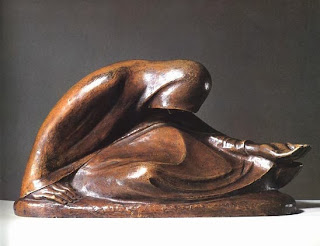Ernst Barlach (1870-1938) was a German Expressionist artist best known for his sculptures. In fact, I like his sculptures more than his wood block prints (!) because they have a wonderful boldness and simplicity, and yet they simultaneously have a delicacy and lightness that shouldn't be possible with such heavy, angular shapes. Although his wood block prints don't have the same simplicity, with a much sketchier, more textured look, they still have a lot in common with the sculptures.
I've chosen two images of God, representing the first day and the seventh day from Barlach's book The Transformations of God. Despite the two images I've chosen, the seven woodcuts in the series aren't the seven days of creation as described in the Bible. The middle images represent human activities, human lack of spiritual fulfillment, suffering, the power of love… However, the bracketing images of God as a figure of power, stability, and compassion sum up Barlach's message of divine presence.
Now, my personal theology most definitely does not see that divine spirit as a big old man with a beard. That said, I recognize that all our images and descriptions of God, all our names and words for the divine, are only metaphors, partial hints at different aspects of something we can never wholly grasp, like the Blind Men and the Elephant. And given that, I'm fine including big-old-man-with-a-beard images as part of the artistic vocabulary that strives to make tangible some small part of our human sense of what's so much greater than we are.
In the first woodcut, you can see a very clear similarity between God's robe and the sorts of draperies Barlach carves in his sculptures. The face, also, has Barlach's signature sharp cheekboned look. The round, rolling, soft clouds, on the other hand, are quite different. I think they make a nice contrast with God's starkly angular figure.
In The Seventh Day Barlach has used no solid black at all, only textured lines. I think this adds to God's appearance of weariness. I usually picture God being a little more triumphant on that last day, but in Barlach's series this piece comes after a lot of suffering and disappointment, so it makes sense that it should show a God who feels a little bittersweet about the creation. Visually, I really like the drape of God's robe and the shape and texture of the mountain behind.
In all his art Barlach shows a concern for the suffering of the outcast and the downtrodden. Yet he doesn't concentrate on the ugliness of our world. Instead he shows the dignity and grace that are present even in sorrow. I admire that.
[Pictures: Russian Beggar Woman I (Russische Bettlerin I), bronze sculpture by Ernst Barlach, 1907 (Image from Galerie Wimmer);
The First Day (Der erste Tag), woodcut by Barlach, 1920-21;
The Seventh Day (Der siebente Tag), woodcut by Barlach, 1920-21 (Images from Spaightwood Galleries).]




No comments:
Post a Comment